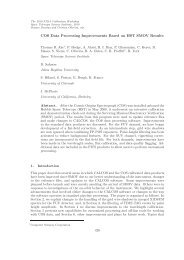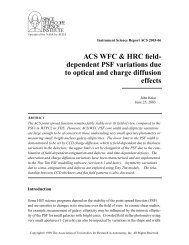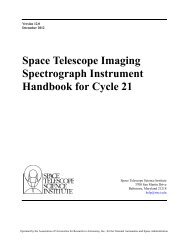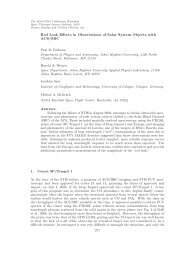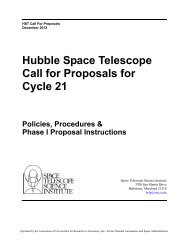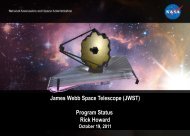STScI Annual Report 2002: A Living Mission
STScI Annual Report 2002: A Living Mission
STScI Annual Report 2002: A Living Mission
Create successful ePaper yourself
Turn your PDF publications into a flip-book with our unique Google optimized e-Paper software.
26 science essays<br />
blown off by the star, which act as crude mirrors scattering<br />
starlight. The Hubble survey of 27 objects detected the<br />
reflection nebulosity of 21 protoplanetary nebulae, all of<br />
which showed an axisymmetry in the circumstellar environment.<br />
This work supports the idea that the appearance<br />
of axisymmetry in planetary nebulae precedes the protoplanetary<br />
nebula phase and most likely originates during<br />
the mass loss in the AGB stage.<br />
The Hubble survey also discovered two new morphological<br />
types of protoplanetary nebulae: ‘star-obvious<br />
low-level-elongated’ (SOLE) nebulae and ‘dust-prominent<br />
longitudinally extended’ (DUPLEX), which are illustrated in<br />
Figure 1. The SOLE and DUPLEX protoplanetary nebulae<br />
are probably the precursors to the elliptical and bipolar<br />
planetary nebulae. Hubble’s excellent point spread function<br />
was critical for revealing the detailed structure of these<br />
nebulae and, for the SOLE nebulae, for improving the contrast<br />
between the central star and the nebula.<br />
Mid-infrared images of protoplanetary nebulae trace<br />
the thermal emission from the circumstellar dust shell.<br />
SOLE nebulae display optically-thin toroids perpendicular<br />
to the elongated reflection nebulae, while DUPLEX nebulae<br />
show optically-thick, compact cores and elongations<br />
aligned with the bipolar reflection nebulae. These morphological<br />
differences translate into spectral energy distribution<br />
differences: SOLE nebulae have two peaks, one in the optical<br />
due to the bright star and one in the infrared due to the<br />
thermal dust emission; DUPLEX nebulae have one dominating<br />
peak in the infrared from the dust shell and an optical excess<br />
due to the reflection nebula. Radiative transfer model calculations<br />
by the author, Ueta, and collaborators support<br />
∆ DEC (arcsec)<br />
∆ RA (arcsec)<br />
2 0 -2 2 0 -2 2 0 -2<br />
∆ RA (arcsec)<br />
4 2 0 -2 -4 5 0 -5<br />
2 0 -2<br />
∆ RA (arcsec)<br />
the conclusion that SOLE nebulae are physically distinct<br />
from DUPLEX nebulae, with shells of lower optical depth<br />
that permit the starlight to leak out to all viewing angles.<br />
We believe that DUPLEX nebulae experienced higher massloss<br />
rates, with higher equator-to-pole mass-loss ratios,<br />
than SOLE nebulae. Interestingly, the DUPLEX nebulae<br />
have a larger range of dust grain sizes (0.001 to 200<br />
microns), which suggests more dust processing.<br />
Independent studies suggest that the presence of longlived<br />
disks can support grain growth in these sources.<br />
Millimeter interferometry of protoplanetary nebulae<br />
by Fong, the author, and collaborators reveals differences in<br />
the kinematics of the molecular gas surrounding the central<br />
star. SOLE nebulae appear to have simple expanding<br />
envelopes, whereas DUPLEX nebulae have bipolar—or<br />
multiple—collimated outflows of molecular gas that collide<br />
with the slower moving, expanding wind. This difference<br />
in kinematics suggests completely different shaping mechanisms<br />
for the two types. AGB mass loss, which is probably<br />
driven by radiation pressure on dust grains, shapes both<br />
SOLE and DUPLEX nebulae. However, DUPLEX nebulae<br />
appear to have some additional physical mechanism that<br />
creates collimated mole- cular outflows that shape the nebulae.<br />
The DUPLEX nebulae appear to have disks, which<br />
suggests that the disk winds driving bipolar outflows in<br />
star formation regions may do the same in these objects.<br />
Stars that develop planetary nebulae distribute most<br />
of the carbon in the universe—and in us. So, the next<br />
time you view a planetary nebula, be in awe of its butterflylike<br />
beauty and be thankful for its enrichments of space<br />
and life. �<br />
Figure 1: The morphological dichotomy of<br />
protoplanetary nebulae shown by Hubble<br />
images (color scale) and ground-based<br />
mid-infrared images (contours). On top, the<br />
SOLE nebulae, with prominent central<br />
stars surrounded by elliptical, low-level<br />
reflection nebulosity and by limb-brightened,<br />
mid-infrared emission from dust tori.<br />
On the bottom, the DUPLEX nebulae, with<br />
exquisite, bipolar, reflection nebulosity and<br />
centrally-peaked, mid-infrared emission<br />
images. In each image, the (Infrared<br />
Astronomical Satellite) IRAS names for<br />
these sources are on top and the filters are<br />
on the bottom (mid-infrared on left and<br />
Hubble on right).





